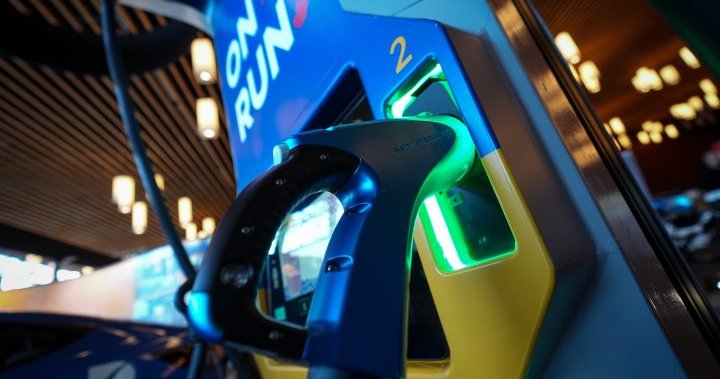While ‘range anxiety’ used to be a factor in purchasing an electric vehicle years ago, consumers have less to worry about when it comes to how far their EV can go, experts say.

I’ve owned an EV for two years now, have over 50,000km on it, and have never once needed a DC fast charger simply because I don’t go on road trips longer than a few hundred kilometers. Even my in-laws are 250km away, and its fairly easy to level 1 charge overnight with a standard wall socket before driving home at the end of the weekend. Uses about 60% of my battery on that trip.
I’m not worried about needing a faster charger if I do go on a longer trip, they seem to be on all the highways near me in any direction.

I’m at 167,000km, give or take. My local travel is completely transformed. I never need to visit gas stations, ever. Range anxiety isn’t a thing. I get 420km+ in the summer, and 300km+ in the winter. Yea, sure, in very cold days the range is lower, but the range is always higher than I need for my in province driving. Range anxiety is not a thing because years of driving has taught me that a full battery is always more than ill reasonably use in a day, even with a 110km daily round trip commute.
Long range trips, which I make several a year (510km each way) do need a charge stop. But yea, there are chargers all over. I use the DC fast sometimes, but mostly I use the slower lvl 2 chargers. Why, what kind of lunatic am I? The kind that enjoys parking his car in a small city or town, visiting the unique shops and restaurants and breweries and not feeling rushed. Catch me in the library in a small-town playing board games with my kids instead of rushing through life as fast as I can.

How does the heating work in the winter? Is there a pre-heat setting so you dont get into a cold car? Do the heaters keep up with -30c or worse weather?

-30C (real negative 30 celcius, not real feel or wind chill) is so exceedingly rare in PEI that I couldn’t tell you.
What I can say is that I need to commute to work everyday, and for a bit every year that’s - 15 to - 20 C or worse, and I’ve never driven cold.
Yes there is a preheat. It works fine, cabin warms up quick while it’s plugged in. For 2 years I was parking it outside and now I have a garage, in either case it was no problem.

Mine has a precondition option that can both heat the cabin and warm up the battery while still plugged in (a warm battery will give you better range). The heaters keep up, and in fact can warm the cabin faster than on ICE: The latter uses waste heat from the engine, the EV just uses a heating element like a space heater for home would.

Some of the newer cars have a heat pipe from the batteries to the cabin, so waste heat from discharging the batteries also keeps the cabin warm and improves winter ranges.

Does that only work while plugged in?

You can precondition the car plugged in or not. If it’s really cold you will want to plug it in, so you use wall electricity to heat the car instead of the battery.

“Experts say range anxiety is over!”
Me, needing 500km of range to get to my parents in BF nowhere: …
Like, I’m happy for the big city dwellers and all, but “Canada” is a lot bigger than the major metropolitan areas.

An earlier commenter says their parents are 250km away and it only uses 60% of the battery to get there and back

It mostly depends on speed. Need to go 500km at 70kph? Easy. Most EVs can do that. 500km at 120kph? Not so much. If you need the latter, I’d recommend looking at PHEVs.
(Temperature also plays a role, but it’s less significant than speed, especially with all the heat pumps these days.)

Not sure I believe that. It takes less energy to keep a vehicle moving than it does to accelerate it. That’s not going to change whether it’s gas or electric.
No, EVs are not perfect and I’m not saying I have the answers, but it’s amazing how some people are so ready to throw in the towel when one thing doesn’t work out.

Not sure I believe that. It takes less energy to keep a vehicle moving than it does to accelerate it. That’s not going to change whether it’s gas or electric.
Merry Christmas, it’s physics time. When a vehicle is in motion, the forces the motors must fight are governed by the following equations: Ftotal= Fdrag + Frolling= 0.5ρv2CDA + NμR , where:
- ρ = air density (kg/m^3)
- v = velocity (m/s)
- CD = coefficient of drag, defined by the shape of the car.
- A = cross-sectional front-facing area of the car (m2)
- μR = rolling resistance coefficient, which is calculated separately and depends mostly on tire pressure and surface quality. It changes a tiny bit with speed. In the example below, it’s 0.011.
- N = Normal force, or weight of the car (N)
If we take Ftotal and multiply it by the speed of the vehicle, we find the energy wasted per second, or the power needed to maintain that speed. Filling in the blanks for a Tesla Model 3 (because it’s easy to find the numbers) at 120kph (and ideal circumstances!), we find that Ftotal = 347.4 N + 196.4 N, and so Pwasted = 18.13 kJ/s or 18.13 kW. For a battery with 74 kWh usable, this translates to 489.8 km. Inside EVs tested their Model 3 at 112.6 kph and got 498.9 km, so this seems about right.
Now let’s slow things down to 70 kph. Ftotal = 118.2 N + 196.4 N, and our range jumps to 846.7 km. That’s a lot, but hypermilers have gotten more in this particular vehicle. Now, I never said the 70kph example would have stops and starts, but since you brought them up, let’s see if we can recalculate with those in mind.
The energy needed to bring a vehicle up to 70 kph is the kinetic energy adjusted up for a motor’s electrical efficiency, E = (1/.96)(1/2)mv2 = 358.4 kJ or 0.0996 kWh. The energy recuperated when using regen braking is the same, but adjusted down for the regen’s electrical efficiency, E = (0.7)(1/2)mv2 = 240.8 kJ or 0.0669 kWh. So a single stop-start cycle uses a net 0.0327 kWh. I’ll add one such 10-second start-stop cycle every 2 minutes (just spitballing), and recalculate for drag at the new speeds. We end up with an estimate of 733 km. This matches EV-database’s city range estimates in mild weather.
Now, this may seem a bit startling, but the fact that EVs are more efficient in traffic than on the highway has been empirically measured. Personally, I can confirm that my range in my Clarity PHEV is about 50% longer at 45 mph than it is at 75 mph.

It’s never been about range for me. It’s cost.
I bike most of my trips, so it’s easy to justify a $2000 gas guzzling beater if I just need something kicking around in the driveway. My insurance is nearly “free” and gas station visits might be once per quarter.
If I was forced to spend 10x that amount for an EV, then I’d probably drive more often. It would give the complete opposite effect of why I bike. 🤔

“Range has improved,” said Mark Marmer, the owner and founder of energy consultant Signature Electric. “Now most cars and trucks have at least about a 300- to 350-kilometre range, which is a reasonably comfortable thing.”
When on a longer trip, a charge to give an extra 150 kilometres or so will take about 15 to 20 minutes, but that also depends on the speed of the charger, according to Marmer.
Unfortunately, that’s a pretty hard sell when your work day requires more mileage than that, and you want to get home asap.

What percentage of people realistically drive more than 300km per day? We’re talking 2.5-3h on the road per day, not taking traffic into account. Extrapolating 300km per day, over 49 weeks a year, 5 days a week, that’s just shy of 74000km. Who drives that, outside people whose job it is to drive stuff lol?

It doesn’t have to be “per day” - it needs to be often enough that they’ll be deterred from getting an EV.
Look, I’m pro-EV, but I think it’s important to acknowledge that in a country as big as this one, there are going to be people with justified “range anxiety.”

Actually, not only does it not have to be “per day”, it may only have to be once, depending on the situation.
I live in a location where certain types of medical services are ~400km away minimum. The thing that bit me on the ass was needing emergency care for a torn retina. In March, in very bad weather, at the height of the pandemic. That was a five-hour drive during which taking 20 minutes out to charge an EV would not have been a good idea (assuming a charging station was available—not guaranteed in that area). I would not want an EV as my only vehicle unless the range improves considerably, even though I don’t normally exceed 50km/day.

Sure. It is not what the comment I was responding to was referring to.

Some people in healthcare do that, visiting people in their homes and hospitals.

Yes, some people do it. What proportion, realistically?

It takes, what, about five minutes to fuel up a gasoline powered vehicle. Optimistically, in ten years time on a fast charger, 20 minutes for an electric? So theoretically, to maintain the current flow rates on highly trafficked routes (like the 401 from Montreal to Toronto), during peak hours, vehicles need to be stopped at a service station for at least four times as long as they currently are now. It’s also slightly over a 500km long drive, so unless you’re really playing chicken with range you will need to stop at least once (I could be wrong, but I believe most gas powered vehicles can do around 600km range at 120km/h?). I wonder what the land-use requirements will be to charge those vehicles – Walmart parking lots beside the highway may begin to make a killing if they lean into it.
For me, unless my landlord suddenly decides to spend a tonne of money to furnish the first-come, first-serve outdoor parking lot at my building with electric chargers, it’ll be a hybrid after that date (unless I’m rennovicted before then). I wonder if someone is liable for the tripping hazard of extension cords running out the front door and across the sidewalk to street parking.
Obviously I’m being a bit silly and sarcastic here, but the wholly electric by 2035 scheme seems half-baked based on the assumption everyone lives in single family homes and that the amount of intercity travel will decrease in aggregate by then. Rather than say, increasing taxes year on year for gasoline powered ownership and then some heavy investment into things like high speed rail, cycling infrastructure, trams, etc. The solution to cars are too polluting doesn’t have to be the same number or more cars . . .

a couple of thousand dollars
That’s like “a couple of more minutes,” or that famous movie sequel, “a few dollars of more”.
I hope they didn’t pay the temp agency a lot for this editor.

